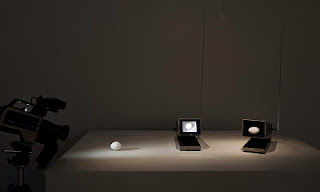Pioneer of Video Art: Nam June Paik
 Electronic Superhighway, 1995,a gift from the artist to the Smithsonian American Art
Electronic Superhighway, 1995,a gift from the artist to the Smithsonian American ArtMuseum, Washington. This 49-channel installation is neon, steel and other electrical parts.
In the Tower: Nam June Paik is at the National Gallery of Art until October 2nd. This Korean-American artist introduced the realm of tv/video art with sculptures made of televisions in 1966. The exhibit encompasses themes and ideas important to art of the last 50 years.
To fully appreciate his work one must see the exhibition in the museum’s East Wing. His art is about tv/video, a relatively new medium in visual art. A room of Paik’s drawings accompany the exhibition and help the viewer understand his thought process. One of the most interesting takes us back to the 60s culture; it’s a drawing of the Pan Am domestic routes represented by bunny-eared TV icons connected by red lines. He seems to have projected that many networks of our lives have been influenced by TV, and perhaps have changed us.
Paik, who died in 2006, is credited with bringing this medium into the realm of contemporary art. Compared to other video artists (there are many today!), Paik is certainly a multimedia artist who thought more in terms of how television and its relatives can be incorporated into art, rather than end and aim of the art itself.
 One Candle, Candle Projection, 1988-2000 candle, candle monitoring device, closed circuit camera, projectors, distribution amplifier, and 5″ color monitor, dimensions variable Nam June Paik Estate
One Candle, Candle Projection, 1988-2000 candle, candle monitoring device, closed circuit camera, projectors, distribution amplifier, and 5″ color monitor, dimensions variable Nam June Paik Estate
In seeing the Paik exhibition, I appreciated this modern artist’s ability to think about the contemporary aims of the society within which he was working and then make a statement. Personally, he disliked the passivity of television but could not ignore its influence on culture. In an ironic play on this notion, his Standing Buddha with an Outstretched hand is a meditation on the act of watching, using a traditional bronze sculpture as a backdrop to the modern technology. Time passes, but the statue stays the same, and Paik effectively made a statement on the meaning of television in life while connecting it to traditional meditation. Paik was trained a a classical musician and was friends with John Cage.
video installation with closed circuit camera, Sony KV-4000 Color Television Receiver, emptied Sony KV-4000 Color Television Receiver, and 2 hen eggs
Nam June Paik Estate © Nam June Paik Studios, Inc. 2010
Like 20th century artists of the Dada, Surrealist and Conceptual movements, his Three Eggs reflects on the question of what is real and what is image. Three Eggs is 1) a video camera projecting on an egg; 2) a tv screen showing the projected image of this egg, and 3) a tv monitor with the screen removed– replaced by an egg. There is irony and humor, but the passage of time is important to these 3 images, as well, having been made over 7 years. It reminds the student of Joseph Kosuth’s One and Three Chairs or Rene Magritte’s Treason of Images, 1929, works found in most art history textbooks.


Recent Comments